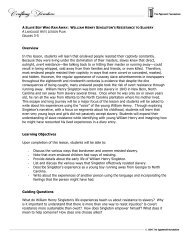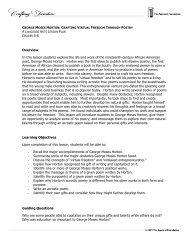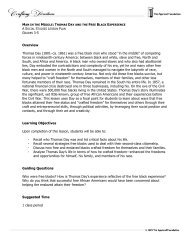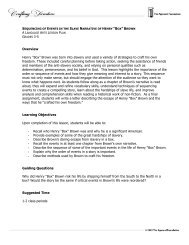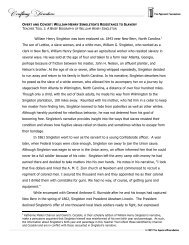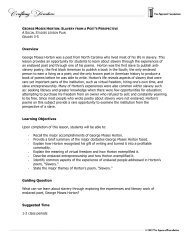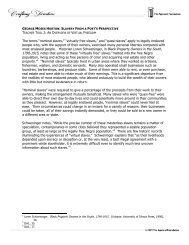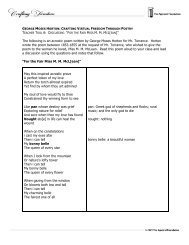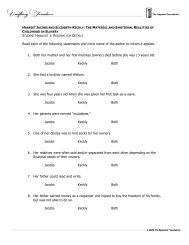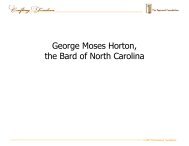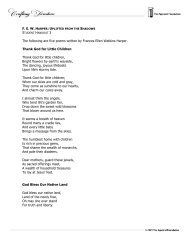George Moses Horton Lesson Plan - Crafting Freedom
George Moses Horton Lesson Plan - Crafting Freedom
George Moses Horton Lesson Plan - Crafting Freedom
You also want an ePaper? Increase the reach of your titles
YUMPU automatically turns print PDFs into web optimized ePapers that Google loves.
Preparing to Teach the <strong>Lesson</strong><br />
1. If you are already familiar with <strong>George</strong> <strong>Moses</strong> <strong>Horton</strong>, skip to step 2. To learn about<br />
<strong>Horton</strong> you can read a brief biography in Teacher Tool 1. You can also read an<br />
overview of his life at http://docsouth.unc.edu/fpn/hortonlife/bio.html.<br />
2. For a greater understanding of <strong>Horton</strong>’s views of slavery, you may read some of his<br />
other works such as:<br />
- “The Slave’s Complaint” at http://docsouth.unc.edu/southlit/horton/horton.html<br />
- “On Slavery and Liberty” at<br />
http://www.theotherpages.org/poems/2001/horton0101.html<br />
- “Division of an Estate” at http://docsouth.unc.edu/fpn/hortonpoem/menu.html<br />
- “The Creditor and his Proud Debtor” at<br />
http://docsouth.unc.edu/fpn/hortonpoem/menu.html<br />
- “<strong>George</strong> <strong>Moses</strong> <strong>Horton</strong>, Myself” at<br />
http://www.theotherpages.org/poems/2001/horton0105.html<br />
3. Review Teacher Tool 2, which provides an overview of virtual freedom.<br />
4. Review Teacher Tool 3, which provides an overview of enslaved entrepreneurship.<br />
5. Review the PDF slide show that accompanies this lesson plan and Teacher Tool 4. The<br />
PDF slides are intended to introduce students to <strong>George</strong> <strong>Moses</strong> <strong>Horton</strong> and Teacher Tool<br />
4 contains lecture notes on the life of <strong>Horton</strong> to accompany each of the slides.<br />
6. Review Teacher Tool 5, which contains the poem, “Slavery” and notes based on the<br />
questions to help you lead a discussion on the poem.<br />
7. Review Student Handout 1, which contains question about <strong>George</strong> <strong>Moses</strong> <strong>Horton</strong>’s life<br />
based on each PDF slide.<br />
8. Review the short video “<strong>George</strong> <strong>Moses</strong> <strong>Horton</strong>, Poet Entrepreneur.” This video<br />
demonstrates how <strong>Horton</strong> turned his literary talent into a business writing love poems.<br />
This venture was a precursor to the greeting card business of today.<br />
9. Review Student Handout 2, which contains the poem “Slavery” and questions for<br />
students to answer. Notes to help you discuss the poem are provided in Teacher Tool 5.<br />
Teaching the <strong>Lesson</strong> (Suggested Steps)<br />
1. Explain to students that the topic of the lesson is a man named <strong>George</strong> <strong>Moses</strong> <strong>Horton</strong>,<br />
an American poet who lived in the South before the Civil War. To engage student<br />
interest, open the lesson plan by showing the short video titled “<strong>George</strong> <strong>Moses</strong> <strong>Horton</strong>,<br />
Poet Entrepreneur.” Withhold that <strong>Horton</strong> was enslaved until after students see the<br />
video as this should come as a surprise and spark further interest in <strong>Horton</strong>.<br />
2. Using Teacher Tool 4 as a lecture reference, present the PDF slide show to introduce<br />
<strong>George</strong> <strong>Moses</strong> <strong>Horton</strong>. Stop the slide show at slide 9. Slides 10 and 11 will be used<br />
later.<br />
3. Distribute Student Handout 1 and show each slide again, allowing students time to write<br />
a brief response to each question.<br />
4. Using the information in Teacher Tools 2 and 3, provide students with an overview of<br />
the concepts of virtual freedom and enslaved entrepreneurship, noting that <strong>Horton</strong><br />
turned his poetry into a successful business, which allowed him to live in virtual freedom<br />
while paying his owner a portion of his profits. Be sure to note that not all of <strong>Horton</strong>’s<br />
experiences as a slave were unusual, highlighting the many limitations that he shared<br />
with the majority of those enslaved such as seeking literacy and greater knowledge<br />
when there were few opportunities for education; attempting to purchase his freedom



